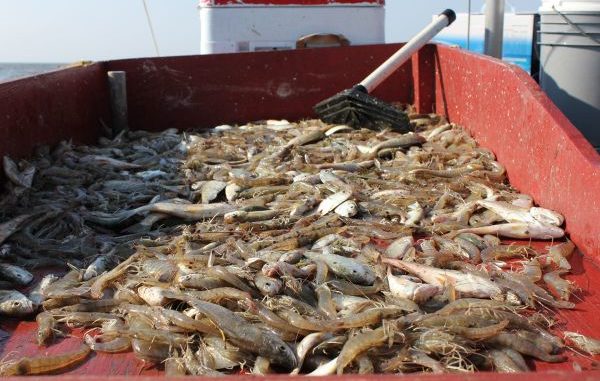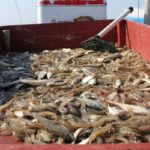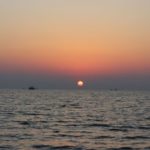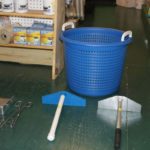
Recreational shrimp trawling is not as popular as it once was — but it is still just as much fun.
It was opening day of the 2012 trawling season for the east bank, and I had arrived a little early at the boat launch. As I sat on my tailgate in the darkness, waiting for my host for the day to arrive, my mind began to drift back to the days in the 1970s and ’80s when the opening day of shrimp season was one of the most-sacred events of the year for many of us — maybe only second to the opening day of duck season.
Back then, the predawn roadways were choked with boats of all kinds clad in homemade rigging, picking boxes and makeshift fantails. Ice was sold out everywhere, and there were long lines at the few gas stations that were open that early.
The lines at boat launches stretched for blocks, and impatient tempers often flared up in the rush to be on the water for the 6 a.m. opening.
When darkness would finally fade into light, an armada of boats would be revealed, reminiscent of the D-Day invasion fleet.
How things have changed since then. Today, the parking lot was almost empty, and the opening day of shrimp season would virtually go unnoticed — except by the commercial shrimpers and a handful of recreational shrimpers who never received the memo that shrimping was no longer fun.
These diehards would head out this morning, like they always have, to reap the bounty of our bayous and lakes, and bring home an ice chest or two of shrimp and maybe even a hamper of crabs for their family and friends to enjoy that evening.
But more than that, they would do it to return and relive the days when life was less hurried and busy, and just being out there on the water was priceless.
For me, it would be the first time in nearly 25 years that I had been trawling, and I must say, I was excited about it. The nostalgic tug of the great times I experienced many years ago with my dad, my family and my friends seemed to come to the surface. It was like meeting up with an old friend, when the years apart seemed to melt away with a familiar smile or chuckle.
My thoughts were interrupted by the headlights of the truck coming into the parking lot — it was time for me to catch up.
Participation in recreational trawling has decreased significantly in the last 30 years. The reasons are many. Perhaps it is just too easy to buy shrimp for a meal or to stock a freezer. Maybe it’s the busy schedules everyone now seems to have and many choose to spend their limited free time involved in fishing and other more “active” sports.
But whatever the reasons are, those who remember how much fun it once was should consider trying it again. Remember: It is not just about catching shrimp, but like most outdoor pursuits it is about the quest for adventure. Just ask those who are addicted to it.
Dave Glaviano has only missed one opening day since 1980, and he was kind enough to invite me aboard for this opening day. During his college years, Glaviano wanted to learn how to trawl, and was fortunate enough to be invited to go trawling with a friend and his father who had a camp off of Haynes Boulevard in eastern New Orleans.
He was immediately hooked.
“I just love being out there — just being out there with the sun coming up, a cool breeze, the trawl down, no rush, just relaxing and getting away from it all,” Glaviano said. “It simply does not get any better.”
We made a quick trip down Bayou Bienvenue and entered Lake Borgne to join the commercial fleet of shrimping boats already there at dawn. After pulling up on the throttle, Glaviano quickly began his systematic and familiar routine of putting the net out.
He was almost robotic in his actions. Over the years, he has picked up many tricks, and in no time the net was out.
“You see how that’s done?” he said with a smirk.
As we slowly moved across the slick-calm waters of Lake Borgne pulling the 16-foot trawl, I asked Glaviano to give some advice to those who want to start trawling for the first time or those who would like to start again.
“You really need to go with someone who knows what they are doing before going out on your own,” he said. “You are not going learn this by talking to people or reading about it. There’s a lot to it. It’s not hard — just a lot of little details that can only be learned by someone showing you. Safety is a big part of it, you don’t want get yourself into trouble.”
I asked Glaviano how he picks where to go, and he said that’s pretty simple.
“Go where the shrimp boats are,” he said. “They know where the shrimp are. If you are trawling and you do not see any shrimp boats around, you probably won’t catch much.”
Areas Glaviano recommended included Lake Borgne, around the Chef, and in Bayou Bienvenue between the MRGO and Lake Borgne. He also likes Lake Pontchartrain around the Twin Spans and the east side of the Causeway.
“I ask people who travel these bridges everyday to call me when they see shrimp boats trawling in these areas,” he said. “It works every time.”
After an hour of dragging, it was time to pick up the net, so Glaviano positioned the boat downwind of the trawl so the boat did not float over the net. We began to pull in the ropes, followed by the boards and finally the net.
“You can’t be in a hurry,” Glaviano said. “Just take your time and shake the shrimp down to the pocket.”
Soon the bulging pocket was visible, loaded with medium-sized shrimp.
“I might need a hand,” Glaviano chuckled.
It was a good haul that nearly filled a 48-quart ice chest with fresh shrimp. Another opening day had begun with a bang.
Gus at Gus’ Tackle and Nets in Slidell has been involved in shrimping since he was a kid, and I spoke with him to get some valuable information on getting set up for trawling and the equipment and supplies that are necessary.
For Gus, trawling has been a family tradition for many years and Gus’ father has been making trawls for the last 30 years. Trawl-making first started as a hobby, making nets for his own use, and for family and friends.
But soon he started to receive more requests, and making trawls became a business.
According to Gus, the design of their trawls has evolved over the years and has elements of both a flat trawl and a balloon trawl that he believes is ideally suited for our local waters.
I asked Gus why he enjoys trawling.
“It really brings me back to my childhood when I would go to a camp we had in Violet and sometimes trawl for days at a time with my dad,” he said. “Those were some great times that I will never forget. People just do not seem to have the time anymore just to relax and take it easy.
“That is what trawling is all about.”
I asked Gus what is involved for someone who wants to start trawling.
“A lot of what people are doing now is trawling for bait,” he said. “That is pretty easy to do with a small net that is easy to handle.
“If you want to catch enough shrimp to eat, you probably would want to pull at least a 16-foot net.”
I asked Gus to tell me how to get set up for shrimping.
“We sell the complete package that includes trawl ropes, trawl boards (properly sized for the net), the trawl net, tickle chain, and tail rope with a float, and all the thimbles and shackles needed,” he replied.
Other supplies that Gus recommends are some baskets, rakes (to separate the catch), crab tongs and a hamper for the crabs.
Gus went on to tell me that almost any boat can be used for trawling, and pulling pipes are not required.
“You can pull from your cleats,” he said. “On larger boats, the back cleats work fine. On smaller boats, cleats near the center of the boat work better, especially for turning.
“You will also need a simple picking box. Use a sheet of plywood and construct a low-sided box with one side open. You can put a removable gate on the open side so your catch does not crawl out.”
Gus also shared some productive areas.
“Lake Borgne is probably the best area to catch enough shrimp to eat,” he said. “Lake Pontchartrain is good at times, especially for big shrimp, but in my opinion you need a pretty big net to catch enough of them.”
Some other tips the experts mentioned is that during the early brown shrimp season (May through July), the correct speed for trawling is about 2 to 3 mph. During the white shrimp season that normally starts in August, you want to trawl a little faster because white shrimp are stronger swimmers and can get out of the net easier.
Most people trawling for bait limit their drags to no longer than 10 minutes. When trawling for shrimp to eat, most trawl for about 45 minutes to an hour before picking up.
If you remember the good ole days when you would go trawling and afterwards have a shrimp boil on the back patio with your family and neighbors, why not catch up on old times?
And don’t forget to bring the kids along so they can experience a truly unique part of our culture. Everyone will have a great time, and maybe you will pass on a cherished tradition.





